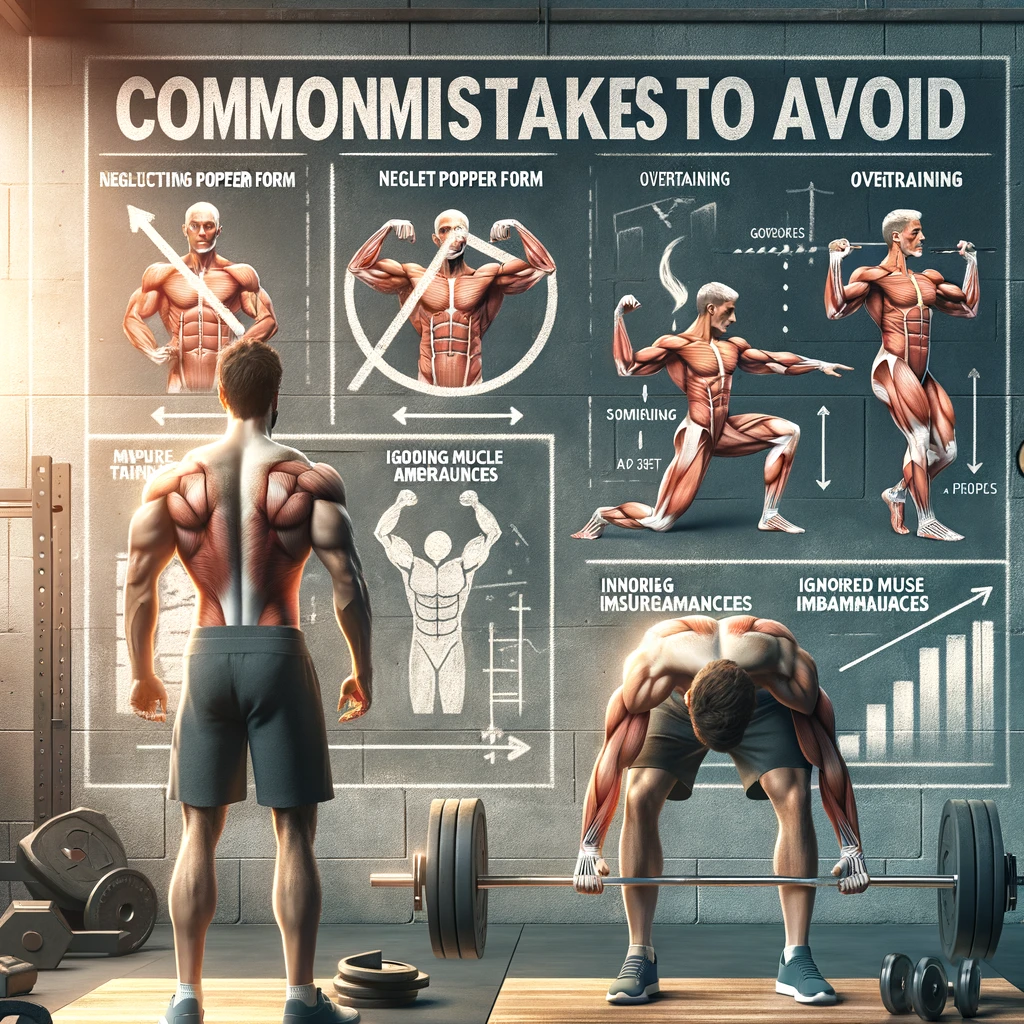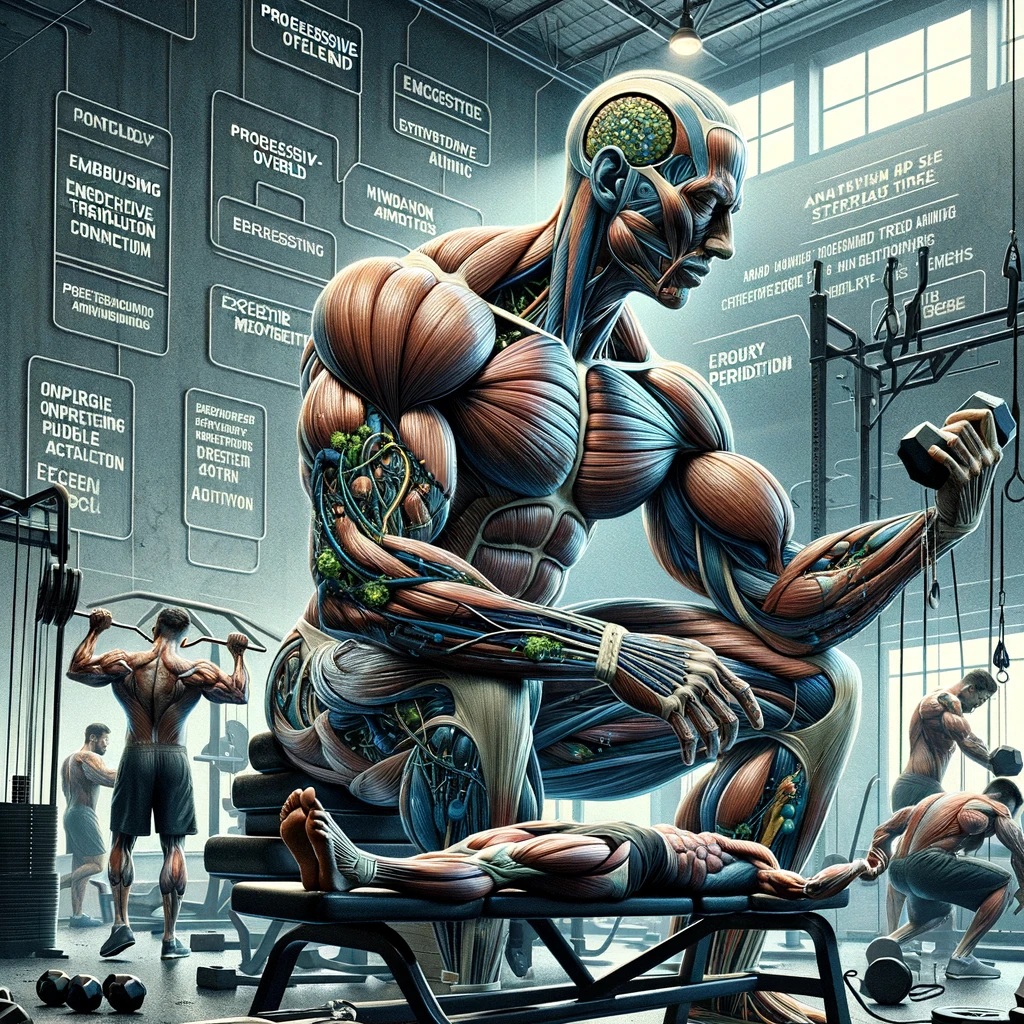Introduction
In the world of getting fit and strong, there are some muscles that people really like. These are the biceps and triceps. They make your arms look good and help you do lots of things in your daily life and sports. This guide will teach you all about training these muscles. You’ll learn how to make your arms stronger and look more defined.
Understanding Biceps and Triceps
Before we start talking about how to train these muscles, it’s important to know about their parts and what they do. The biceps brachii, which most people just call biceps, is a muscle with two parts found in the front of your upper arm. Its main jobs are bending your elbow and turning your palm up. On the other side, the triceps brachii, or triceps, is a muscle with three parts located in the back of your upper arm. Its main job is to straighten your elbow.
Contrary to popular belief, the biceps and triceps are not solely aesthetic muscles but are crucial for various daily activities, from lifting groceries to performing athletic maneuvers. By comprehending their anatomy and function, you can better tailor your training regimen to maximize their strength and development.

Effective Exercises for Biceps and Triceps
To effectively target the biceps and triceps, it’s imperative to incorporate a variety of exercises that engage these muscles from different angles and ranges of motion. Here are some of the most effective exercises for biceps and triceps:
Biceps Exercises:
- Barbell Bicep Curl: Stand upright with a barbell in hand, palms facing forward. Curl the barbell upwards while keeping your elbows stationary, then lower it back down with control.
- Dumbbell Hammer Curl: Hold a weight in each hand with your palms facing each other. Bend your elbows and lift the weights-up toward your shoulders, then lower them back down.
- Concentration Curl: Sit on the bench with a dumbbell in s hand, elbow resting on the inner thigh. Curl the weight upwards while keeping the upper arm stationary, then lower it back down.

Triceps Exercises:
- Tricep Dips: Stand between two bars that are parallel to each other. Hold yourself up with your arms straight. Bend your elbows to lower your body down until your upper arms are flat, then push yourself back up.
- Tricep Pushdown: Connect a rope or bar to a high pulley on a cable machine. Hold onto the rope or bar with your palms facing down and keep your elbows close to your body. Push the rope or bar downwards until your arms are completely straight, then go back to how you started.
- Overhead Tricep Extension: Hold a weight, like a dumbbell or barbell, above your head with both hands, arms straight. Bend your elbows to lower the weight behind your head, then straighten them again to lift the weight back up.

To work your biceps and triceps well, include different kinds of exercises in your routine. Some exercises work lots of muscles at once (compound exercises), while others focus on just one muscle (isolation exercises). Try doing each exercise 3-4 times, with 8-12 repetitions each time.
Sample Workout Routine
To provide a structured approach to biceps and triceps training, here’s a sample workout routine that you can follow:
Day 1: Biceps
- Barbell Bicep Curl: 3 sets x 10 reps
- Dumb-bell Hammer Curl: 3 sets x 12 reps
- Concentration Curl: 3 sets x 10 reps (each arm)
Day 2: Triceps
- Tricep Dips: 3 sets x 12 reps
- Tricep Pushdown: 3 sets x 12 reps
- Overhead Tricep Extension: 3 sets x 10 reps
Day 3: Active Rest or Cardio
Do some easy activities like walking, jogging, or biking to help your blood flow and make it easier for your body to recover. Or, you can do yoga or stretches to become more flexible and move better.
Day 4: Biceps and Triceps
- Superset:
- Barbell Bicep Curl: 3 sets x 8 reps
- Tricep Pushdown: 3 sets x 10 reps
- Superset:
- Dumb-bell Hammer Curl: 3 sets x 10 reps
- Overhead Tricep Extension: 3 sets x 12 reps
Day 5: Active Rest or Flexibility Training
- Focus on activities that promote flexibility and joint mobility, such as yoga, Pilates, or foam rolling. Incorporate gentle stretches to alleviate muscle tightness and prevent injury.
Day 6: Biceps and Triceps
- Circuit Training:
- Alternating Dumbbell Curl: 3 sets x 12 reps (each arm)
- Tricep Kickback: 3 sets x 12 reps (each arm)
- Cable Bicep Curl: 3 sets x 10 reps
- Skull Crushers: 3 sets x 10 reps
Day 7: Rest and Recovery
- Allow your muscles to recuperate and repair by taking a complete rest day. Focus on adequate hydration, nutrition, and quality sleep to support the recovery process.
To make sure your muscles develop well and you don’t train too much, switch between workouts that focus on biceps, workouts that focus on triceps, and workouts that work both muscles together during the week. Pay attention to how your body feels and change how hard you’re working out based on how fit you are and how quickly you recover.
Nutrition Tips for Muscle Growth
Just working out isn’t enough to make your muscles grow the best they can; you also need to eat right. Food gives your muscles the stuff they need to repair and grow. Here are some tips to help your biceps and triceps training with your eating:
1. Protein Intake:
Make sure you eat enough good protein from foods like lean meats, chicken, fish, eggs, milk, and plant-based proteins like tofu and tempeh. Try to have something with protein in it within 30 minutes to 1 hour after you finish working out. This helps your muscles get better faster.
2. Carbohydrates for Energy:
Include foods with complex carbohydrates in your diet. These are foods like whole grains, fruits, vegetables, and beans. They give you energy for your workouts and help fill up your energy stores in your muscles. Eat more carbohydrates before and after you work out to have energy for tough workouts and to help your muscles recover.
3. Healthy Fats:
Eat foods with healthy fats like avocados, nuts, spores, olive oil, and fatty fish such as salmon and mackerel. These fats help your body make hormones, keep your joints healthy, and make you feel good overall. Try not to eat too much saturated and trans fats. Instead, choose unsaturated fats, which are healthier.
4. Hydration:
Make sure to drink enough water every day, especially before, during, and after you exercise. Not having enough water can make it hard for you to do your best, slow down how quickly you get better after exercising, and make it more likely for you to get muscle cramps or hurt yourself. Try to drink around 8 to 10 glasses of water every day, but you might need more if you’re very active or it’s really hot outside. Adjust how much water you drink based on how much you’re moving around and the weather.
5. Timing and Portion Control:
Try to pay attention to what you eat and how much you eat to make sure you’re getting the right mix of nutrients and calories to help you reach your fitness goals. Eat smaller meals and snacks more often to keep your energy levels steady and stop yourself from eating too much at once. Think about when you eat, especially before and after you exercise, to help you perform better and get better after you’re done exercising.
By adopting a well-rounded and nutrient-dense diet that prioritizes protein, carbohydrates, healthy fats, and hydration, you can fuel your workouts, promote muscle growth, and enhance overall athletic performance.

Rest and Recovery
In the pursuit of building stronger and more defined biceps and triceps, it’s crucial not to overlook the importance of rest and recovery. While challenging workouts stimulate muscle growth, it’s during periods of rest that muscle repair and adaptation occur. Here are some strategies to prioritize rest and recovery:
1. Adequate Sleep:
Try to sleep for about 7 to 9 hours each night to help your muscles recover, regulate your hormones, and keep your body and mind healthy. Make sure to go to bed and wake up at the same time every day, and do things that help you relax before bedtime, like reading or taking a warm bath. Make sure your bedroom is set up to help you sleep well, like keeping it dark and quiet.
2. Active Recovery:
On days when you’re not doing intense exercises, try to do some light activities like walking, swimming, or easy yoga. These activities help your blood flow, make your muscles less sore, and help you get better faster. Doing light exercises on rest days can also help make your muscles less stiff, make you more flexible, and get rid of waste products from your muscles more quickly.
3. Foam Rolling and Stretching:
- Utilize foam rollers, massage balls, and mobility tools to release tension, alleviate muscle tightness, and improve range of motion. Perform dynamic and static stretches targeting the biceps, triceps, shoulders, and surrounding muscle groups to enhance flexibility, prevent injury, and enhance recovery.
4. Listen to Your Body:
Listen to your body when you feel tired, sore, or like you’re doing too much exercise. Change how much, how hard, and how often you train based on how you feel. Make sure to take days off and easier weeks in your training plan to stop yourself from getting too tired, help your body get better, and keep improving over a long time.
By prioritizing rest, sleep, and recovery as integral components of your training regimen, you can optimize muscle growth, prevent injury, and maintain overall health and well-being.

Common Mistakes to Avoid
When you’re exercising your biceps and triceps, doing it right can give you great results. But sometimes, people make mistakes that can stop them from getting better and even hurt themselves. Here are some things to watch out for:
1. Neglecting Proper Form:
- Focusing on lifting heavier weights at the expense of proper form and technique can lead to compromised muscle activation, increased injury risk, and suboptimal results. Prioritize quality over quantity, and ensure full range of motion and controlled movements during exercises to maximize muscle engagement and minimize stress on joints.
2. Overtraining:
- Excessive volume, frequency, or intensity of biceps and triceps training without adequate rest and recovery can lead to overtraining, fatigue, and diminished performance. Allow for sufficient rest days, vary your training stimuli, and listen to your body’s signals to prevent overtraining and promote long-term progress.
3. Ignoring Muscle Imbalances:
- Focusing solely on biceps or triceps training while neglecting antagonist muscle groups such as the back, chest, and shoulders can create muscle imbalances and increase the risk of injury. Incorporate balanced, full-body workouts that target all major muscle groups to maintain symmetry, stability, and functional strength.
4. Lack of Progression:
- Failing to progressively overload the muscles by increasing resistance, volume, or intensity over time can plateau results and impede muscle growth. Implement progressive training techniques such as adding weight, increasing repetitions, or varying exercise tempo to continually challenge and stimulate muscle adaptation.
5. Poor Nutrition and Hydration:
Not getting enough protein, not drinking enough water, and not getting all the vitamins and minerals your body needs can make it hard for your muscles to recover, fix themselves, and grow. Make sure to eat a balanced diet with lots of protein, carbohydrates, healthy fats, vitamins, and minerals, and drink enough water to help you do your best and get good results.
If you fix these usual mistakes and use good training ideas, you can make your biceps and triceps exercises work better, lower the chance of getting hurt, and reach your fitness goals faster.

Advanced Techniques and Tips
For those seeking to take their biceps and triceps training to the next level, incorporating advanced techniques and strategies can provide a welcome challenge and stimulate further muscle growth. Here are some advanced tips to consider:
1. Progressive Overload:
- Continuously challenge your muscles by progressively increasing the resistance, volume, or intensity of your workouts. Gradually add weight to exercises, perform additional sets or repetitions, or experiment with advanced training techniques such as drop sets, supersets, or pyramid sets to induce greater muscle fatigue and adaptation.
2. Mind-Muscle Connection:
To make your muscles stronger, pay attention to how each movement feels. Think about squeezing the muscles you’re working on as you move. Picture those muscles working in your mind, and make sure you’re using them as much as you can during your exercises. This will help make your muscles work better and grow stronger.
3. Eccentric Training:
- Emphasize the eccentric (lowering) phase of exercises by controlling the descent of the weight slowly and deliberately. Eccentric training can increase muscle tension, stimulate greater muscle fiber recruitment, and induce muscle hypertrophy and strength gains.
4. Variation and Periodization:
- Incorporate variation and periodization into your training program to prevent stagnation, stimulate muscle adaptation, and prevent overuse injuries. Rotate exercises, change training variables such as rep ranges and rest periods, and cycle between phases of high volume, moderate intensity, and low volume, high intensity to keep your workouts challenging and effective.
5. Recovery Strategies:
- Implement advanced recovery strategies such as contrast baths, cryotherapy, or compression therapy to enhance recovery, reduce muscle soreness, and expedite the repair process. Explore techniques such as active release therapy (ART), myofascial release, or deep tissue massage to address muscular imbalances, trigger points, and soft tissue restrictions.
By incorporating these advanced techniques and tips into your biceps and triceps training regimen, you can break through plateaus, optimize muscle growth, and achieve peak performance in your workouts.

Conclusion
To make your biceps and triceps stronger and look better, you need to do specific exercises, eat well, rest enough, and let your muscles recover. By knowing how these muscles work, choosing the right exercises, planning your workouts carefully, and using advanced techniques, you can shape your arms to look good and be strong and flexible.
Focus on being consistent, patient, and gradually increasing the challenge in your workouts. Pay attention to how your body feels, change your plan if necessary, and be proud of what you accomplish. Whether you want bigger muscles, to be stronger, or to do better in sports, following the advice in this guide will help you succeed in training your biceps and triceps.
So, make your stomach muscles stronger, concentrate on what’s most important, and start on a trip to make the most of your biceps and triceps. Your arms will be grateful for it.


